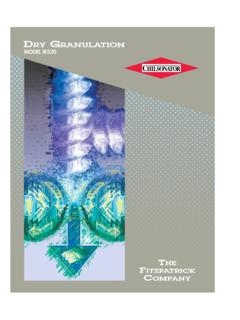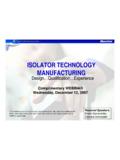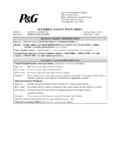Transcription of Aluminum Sulfate, Solid SDS No. 010 - Usalco
1 Aluminum sulfate , Solid SDS No. 010. 3-Mar-2015. Safety Data Sheet 1. IDENTIFICATION. Product Identifier Product Name Aluminum sulfate Manufacturer Other means of identification Usalco , LLC. SDS # 010 2601 Cannery Ave Baltimore, MD 21226. Recommended use of the chemical and restrictions on use Recommended Use Water treatment chemical Emergency Telephone Number Company Phone Number 410-918-2230. Emergency Telephone (24 hr) 800-282-5322. 2. HAZARDS IDENTIFICATION. Appearance White granules or powder Physical State Solid Odor Negligible Classification Acute toxicity - Oral Category 4. Eye Damage/Irritation Category 2B. Signal Word Warning Hazard Statements -Causes serious eye irritation -Harmfull if swallowed Precautionary Statements Prevention -Wear eye/face protection.
2 Wash hands and any exposed skin thoroughly after handling. -Wear protective gloves. -Avoid breathing dust. Precautionary Statements - Response -IF ON SKIN: Wash with plenty of water. If skin irritation occurs: Get medical attention. -IF IN EYES: Rinse cautiously with water for several minutes. Remove contact lenses, if present and easy to do. Continue rinsing. If eye irritation persists, get medical attention. -IF SWALLOWED: Call a POISON CENTER or doctor/physician if you feel unwell. Rinse mouth. Precautionary Statements Disposal Contact your supplier or a licensed contractor for detailed recommendations. Follow applicable Federal, State, and local regulations. Page 1 of 6. Aluminum sulfate , Solid SDS No. 010. 3. COMPOSITION/INFORMATION ON INGREDIENTS.
3 Chemical Name CAS No Weight-%. Aluminum sulfate 10043-01-3 100. 4. FIRST-AID MEASURES. First Aid Measures General Advice After first aid, get appropriate in-plant, paramedic, or community medical support. Eye Contact If in eyes: Rinse cautiously with water for several minutes. Remove contact lenses, if present and easy to do. Continue rinsing. If eye irritation persists: Get medical attention. Skin Contact Wash off immediately with plenty of water. Take off contaminated clothing. Wash contaminated clothing before reuse. Inhalation Remove to fresh air. Ingestion Rinse mouth. Do not induce vomiting. Get medical attention if there are symptoms. Most important symptoms and effects Symptoms May cause eye burns and permanent eye damage. Contact may cause irritation and redness.
4 Irritating to mouth, throat, and stomach if ingested. Vomiting. May cause shortness of breath, nausea, dizziness, and headache. May cause irritation to the mucous membranes and upper respiratory tract. Indication of any immediate medical attention and special treatment needed Notes to Physician Treat symptomatically. 5. FIRE-FIGHTING MEASURES. Suitable Extinguishing Media Aluminum sulfate will not burn. Unsuitable Extinguishing Media Not determined. Specific Hazards Arising from the Chemical If exposed to temperatures greater than 1400 F, Aluminum sulfate will decompose generating toxic and corrosive gas. Hazardous Combustion Products Oxides of sulfur. Protective equipment and precautions for firefighters As in any fire, wear self-contained breathing apparatus pressure-demand, MSHA/NIOSH (approved or equivalent) and full protective gear.
5 Do not release runoff from fire control methods to sewers or waterways. 6. ACCIDENTAL RELEASE MEASURES. Personal precautions, protective equipment and emergency procedures Personal Precautions Use personal protective equipment as required. Ventilate affected area. Other Information Aluminum sulfate may absorb moisture, and powders or crystals can solidify into a single mass. Environmental Precautions Do not discharge wastewaters to the environment or a wastewater treatment plant without authorization from the appropriate officials. Revision Date: 3-Mar-2015 Page 2 of 6. Aluminum sulfate , Solid SDS No. 010. Methods and material for containment and clean up Methods for containment Prevent further leakage or spillage if safe to do so. Methods for Clean-Up Sweep up and shovel into suitable containers for disposal.
6 Flush residue with water. Neutralize with soda ash or lime if necessary. Aluminum sulfate solutions can have a pH. less than two. The neutralization of Aluminum sulfate can generate carbon dioxide. 7. HANDLING AND STORAGE. Precautions for safe handling Advice on Safe Handling Wash thoroughly after handling. Do not eat, drink or smoke when using this product. Use personal protection recommended in Section 8. Minimize dust generation and accumulation. Avoid moisture contamination. Conditions for safe storage, including any incompatibilities Storage Conditions Keep containers tightly closed in a dry, cool and well-ventilated place. Wet Aluminum sulfate will corrode steel. Incompatible Materials Alkalis. Water-reactive materials. 8. EXPOSURE CONTROLS/PERSONAL PROTECTION.
7 Exposure Guidelines No exposure limits noted for product. Exposure Limits for Aluminum metal NIOSH REL - TWA 10 mg/m3 (total) TWA 5 mg/m3 (resp). OSHA PEL - TWA 15 mg/m3 (total) TWA 5 mg/m3 (resp). Appropriate engineering controls Engineering Controls Showers. Eyewash stations. The best protection is to enclose operations and/or provide local exhaust ventilation at the site of the chemical release. Dust emission control may be required depending on the dust generation rate. Isolation operations can also reduce exposure. Individual protection measures, such as personal protective equipment Eye/Face Protection Wear appropriate protective eyeglasses or chemical safety goggles as described by OSHA's eye & face protection regulations in 29 CFR or European Standard EN166.
8 Contact lenses are not eye protective devices. Appropriate eye protection must be worn instead of, or in conjunction with, contact lenses. Skin and Body Protection Wear appropriate clothing to prevent repeated or prolonged skin contact. Respiratory Protection Seek professional advice prior to respirator selection and use. Select respirator based on its suitability to provide adequate worker protection for given working conditions, level of airborne contamination, and presence of sufficient oxygen. WARNING!: Air-purifying respirators do not protect workers in oxygen-deficient atmospheres. General Hygiene Considerations Do not eat, drink or smoke when using this product. Always observe good personal hygiene measures, such as washing after handling the material and before eating, drinking, and/or smoking.
9 Contaminated Equipment: Separate contaminated work clothes from street clothes. Launder before reuse. Remove this material from your shoes and clean personal protective equipment. Revision Date: 3-Mar-2015 Page 3 of 6. Aluminum sulfate , Solid SDS No. 010. 9. PHYSICAL AND CHEMICAL PROPERTIES. Appearance Solid , white granules or powder Odor None Odor threshold Not relevant pH (1% solution). Density <98 lb/cu ft Melting point/freezing point 105 C / 221 F. Initial boiling point and boiling range Not relevant Decomposition temperature 1,400 F. Viscosity Not relevant Auto-ignition temperature Not flammable Evaporation rate; Will not evaporate Flammability ( Solid , gas) Not flammable Flash point Will not burn Upper/lower flammability or explosive limits Will not burn Partition coefficient: n-octanol/water Not relevant Solubility Soluble in water Vapor density None Vapor pressure None 10.
10 STABILITY AND REACTIVITY. Reactivity Not reactive under normal conditions. Chemical Stability Stable under recommended storage conditions. Possibility of Hazardous Reactions Contact with incompatible materials causes exothermic reactions. Hazardous Polymerization Hazardous polymerization does not occur. Conditions to Avoid Contact with incompatible materials. Incompatible Materials Alkalis. Water-reactive materials. Hazardous Decomposition Products Thermal oxidative decomposition of Aluminum sulfate occurs at temperatures greater than 1400 F and can produce sulfur oxides. 11. TOXICOLOGICAL INFORMATION. Information on likely routes of exposure Product Information Eye Contact Causes serious eye damage. Skin Contact Avoid contact with skin.








